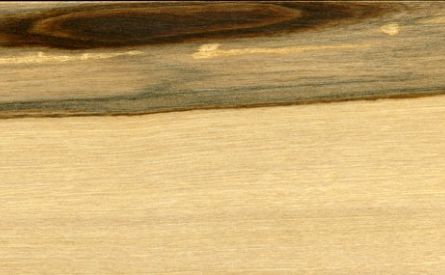CHECHEN BLANCO
White Poisonwood / Sebastiana tuerckheimiana

Local Names
Distribution & Tree
Not to be confused with chechen negro (Metopium brownei, also known as Black Poisonwood), chechen blanco is also native to Guatemala, Belize and southern Mexico, predominantly occurring on plains or hillsides, generally on limestone in low-lying regions 350 meters or less. Tree reaches up to 40 m in height and trunk diameters of 45 cm. The species exudes a caustic white latex from leaves, branches and trunk (hence its local name of White Poisonwood).
Wood Appearance
Processing Properties
Strength & Durability
Wood Uses
Ecological & Social Importance
| Reference Species with Similar Density & Hardness | ||||
| Technical Characteristics | Chechen Blanco | Red Cedar | Black Walnut | |
| Density | kg/m3 | 610 | 530 | 610 |
| Janka Hardness | kgf | 433 | 408 | 458 |
| Bending Stiffness (Modulus of Elasticity) | GPa | 12.4 | 6.1 | 11.6 |
| Bending Strength (Modulus of Rupture) | MPa | 81.2 | 60.7 | 100.7 |
| Crushing Strength | MPa | 27.5 | 41.5 | 52.3 |
| Shrinkage, Radial | % | 3.3% | 3.1% | 5.5% |
| Shrinkage, Tangential | % | 7.2% | 4.7% | 7.8% |
| Shrinkage, Volumetric | % | 10.5% | 7.8% | 12.8% |
| T/R Ratio | 2.2 | 1.5 | 1.4 | |
| Values determined at 12% humidity - Provided for reference only | ||||
|---|---|---|---|---|
DENSITY
JANKA HARDNESS
BENDING STIFFNESS
BENDING STRENGTH
CRUSHING STRENGTH
SHRINKAGE
Values are for reference only and cannot be guaranteed. Wood is a natural material and physical and mechanical properties may vary depending on age, genetics, and other factors. We encourage customers to consult the references provided in the bibliography. For further explanations of wood’s key technical characteristics, an excellent resource is the Wood Database with articles on Density (average dried weight); Janka hardness; Elastic Modulus; Rupture Modulus; Crushing Strength; Radial, Tangential and Volumetric Shrinkage.






